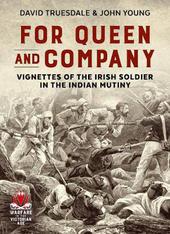
|
For Queen and Company: Vignettes of the Irish Soldier in the Indian Mutiny
Paperback
Main Details
| Title |
For Queen and Company: Vignettes of the Irish Soldier in the Indian Mutiny
|
| Authors and Contributors |
By (author) David Truesdale
|
|
By (author) John Young
|
| Series | Warfare in the Age of Victoria |
|---|
| Physical Properties |
| Format:Paperback | | Pages:112 | | Dimensions(mm): Height 248,Width 180 |
|
| Category/Genre | Asian and Middle Eastern history
Military history |
|---|
| ISBN/Barcode |
9781911512790
|
| Classifications | Dewey:954.0317 |
|---|
| Audience | | Professional & Vocational | | Undergraduate | | General | |
|---|
| Illustrations |
c 60 ills & maps
|
|
Publishing Details |
| Publisher |
Helion & Company
|
| Imprint |
Helion & Company
|
| NZ Release Date |
30 June 2018 |
| Publication Country |
United Kingdom
|
Description
This book records the actions of those Irish soldiers (and others) who were awarded the Victoria Cross in the event known to the British public in 1857 as 'The Indian Mutiny'. Since then, revisionist historians have applied other names to what occurred: a 'war of independence', 'a revolt', or 'a great rebellion'... none of these are accurate for the events that began in Meerut on Sunday, 10 May 1857: it was a mutiny; when soldiers refused a lawful command, it was a mutiny. Those former members of the Indian regiments were mutineers and those civilians who joined or supported them were rebels... these were the words of the time and, in recounting the activities of the time, these are the words that should be used. It took two and a half years to quell the Mutiny, and more than half the regiments of the British Army would, at some stage, see action - and this involved only the Indian troops in one of three Presidencies. While many regimental records show the names of those men who were wounded, or who died of disease or were killed in action - allowing a total number to be calculated - the overall cost to the native populations of Indian towns and villages can only be guessed at.
Author Biography
David Truesdale retired in 1998 and since then has produced seven books on military history as well as writing for films and television and producing battlefield guides. For relaxation he paints in watercolours following the Kelly and Moffett schools of innovation, photographs wildlife' listens to good music, drinks red wine and finds that Tommaso Albinoni (1671-17450) and his Oboe Concerto in D Minor, Op.9, No.2, has been an inspiration during difficult times in any manuscript. John Young was born in London in 1956. He has Irish roots on both the maternal and paternal sides of his family. He was educated in Blackheath and north-west London. A visit to the cinema in 1964 sparked his passion in the Zulu War. A passion which he has maintained throughout his adult life. During that time he has contributed to a number of works on the Zulu War. His first experience of writing on the subject was in Soldiers of the Queen - the journal of the Victorian Military Society in which he served as an officer of the society, before being elected as the chairman of Anglo-Zulu War Research in 1991. The society was re-launched as the Anglo-Zulu War Royal Research Trust in which John is only officer of the trust who is not a member of the Zulu Royal House. His previous book on the Zulu War was They Fell Like Stones: the Battles and Casualties of the Zulu War, 1879, published in 1991. As well as this he has written a number of articles on the Zulu War which have been published in various journals and online. He is married with two adult sons. David Truesdale retired in 1998 and since then has produced seven books on military history as well as writing for films and television and producing battlefield guides. For relaxation he paints in watercolours following the Kelly and Moffett schools of innovation, photographs wildlife' listens to good music, drinks red wine and finds that Tommaso Albinoni (1671-17450) and his Oboe Concerto in D Minor, Op.9, No.2, has been an inspiration during difficult times in any manuscript.
|